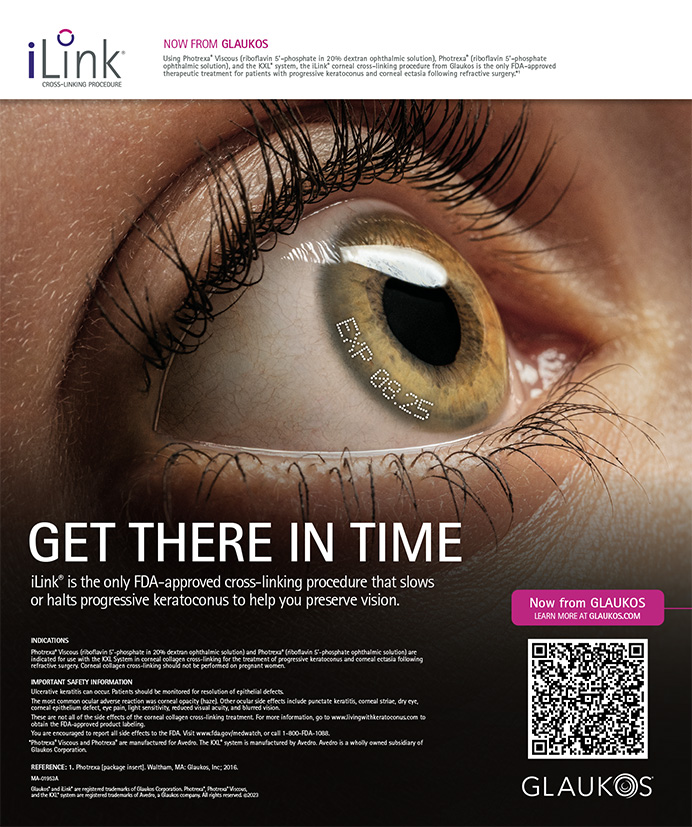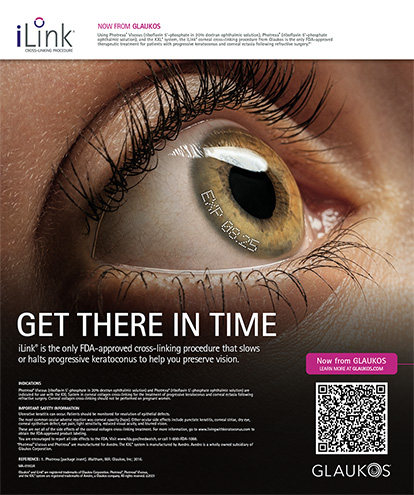Irregular astigmatism is a disturbing optical phenomenon characterized by symptoms such as glare, halos, ghost images, blurring, and monocular diplopia. Because eyes affected with irregular astigmatism are not correctable to 20/20 with glasses, these patients become dependent on rigid contact lenses, and if they cannot tolerate these lenses, their vision quality is extremely poor. The condition can be congenital, as is the case with corneal ectasia, or it can be acquired.1 Today, the most common cause of acquired irregular astigmatism is the occurrence of complications during and after a refractive procedure. Decentration of the laser treatment during correction of a refractive error is a prime example of a complication that can cause one of the most severe and disturbing forms of the condition. Because of the ?handicapped? state of eyes affected by such decentrations, the FDA has recently approved the Custom-Contoured Ablation Pattern (C-CAP) Method (VISX, Inc., Santa Clara, CA) under a humanitarian device exemption (HDE) when used in conjunction with the Vision Pro ablation planner of the Atlas topography unit (Zeiss-Humphrey, Dublin, CA).
CREATING A LINK
The C-CAP Method is a software upgrade that was launched by VISX in April 1999 with the intention of producing ?topography-assisted excimer laser ablations,? or the use of corneal topography to plan a treatment designed to regulate the contour of any cornea, regardless of shape, asymmetry, or irregularity. The C-CAP Method enables the surgeon to use excimer laser beams between 0.6 and 6.5 mm in diameter. Various excimer laser beam shapes such as ellipses, cylinders, or slits allow the surgeon to direct the beam to any area of the cornea from the center of the pupil to several millimeters off-center in any axis. The program also allows the surgeon to predetermine up to 20 different sequential treatments for the same eye and condition.
The C-Cap Method creates a link between the topography map and the excimer laser, which gives it the title topography-assisted excimer laser ablation. It is the surgeon, however, who controls the ablation and sets the treatment parameters, such as the number of ablations, location (on- or off-axis), shape, depth, and size of each. These determinations are made based on clinical judgment, the needs of the patient, pachymetry, and elevation topography. The refractive defect can be difficult to measure, but as the objective is to regulate the corneal contour, it is irrelevant in this type of treatment.
PERFORMING C-CAP ABLATIONS
The first step in the procedure is a patient examination focusing particularly on elevation topography. The results of this examination are used to determine specific ablation parameters, such as the location of the most elevated areas of the cornea in relation to the center of the pupil on both the horizontal and vertical meridians, as well as the definitions of the shapes, sizes, and depths of the elevated areas. In addition, if the ablation is to be cylindrical or elliptical, the axis must be determined.
Once these parameters have been defined, the surgeon programs the information into the VISX Star S3 by selecting the ?C-Cap? option on the laser's computer. Using the computer's Cartesian coordinates and the depth of the ablation, which is derived from the elevation found on the topography map, the surgeon has full control of the order and nature of the progression of every treatment, with the ability to define the shape, size, and location of the ablation relative to the visual axis.
CLINICAL RESULTS
Since the introduction of the software in April 1999, hundreds of patients have been treated internationally with the C-CAP Method.2 The results of these studies have focused primarily on two groups of patients, those treated for keratoconus and those treated following refractive surgery. Prior to the treatment, 67% of the eyes in the keratoconus group were 20/400 or worse uncorrected. Postoperatively, 75% had achieved UCVA of 20/60 or better. Eighteen percent of the eyes gained one or more lines of BCVA, and there was only one occurrence of an eye losing one line of BCVA. The principal motivating factor for the surgery, contact lens intolerance, was addressed satisfactorily, as only 13% of the patients required contact lenses after 3 years of follow-up.3
CASE STUDY
Five months prior to consultation, a 36-year-old white male commercial pilot underwent an excimer laser procedure for the correction of myopia. The surgeon decentered the ablation in the patient's right eye because of a large nasal hinge. The patient complained of ghost images and halos after surgery, which are significantly disturbing images for a pilot. His UCVA was 20/30, and his BCVA was 20/25 with a refraction of +0.75 -0.50 X 25. Because of a small burn in the hinge, a C-CAP treatment with PRK was performed in September 1999. As of his most recent postoperative examination, the patient reported no symptoms, and his UCVA remained 20/20 with a refraction of +1.00 -0.75 X 85. The patient's pre- and postoperative topography maps are shown in Figures 1 and 2.
CONCLUSION
The C-CAP Method, which has recently been approved by the FDA under an HDE with some restrictions, has proven to be a safe and effective tool in the management of irregular astigmatic conditions such as keratoconus, as well as a therapeutic procedure for the correction of complications resulting from previous refractive surgery. Its use in conjunction with the Vision Pro ablation planner software allows surgeons to perform customized topography-assisted excimer laser ablations.
Mario G. Serrano, MD, is a refractive surgeon at Bogota Laser Refractive Institute in Bogota, Colombia, and an International Trainer for VISX Inc. He does not hold a financial interest in the material presented herein. Dr. Serrano may be reached at (571) 629 3880/3445; marios@sky.net.co
1. Tamayo G, Serrano M: Grid Corneal Marker. A new approach for the treatment of irregular astigmatism. Poster presented at the Pan-American Congress. Cancun, Mexico, May 1997
2. Tamayo G, Serrano M: Early clinical experience using custom excimer laser ablations to treat irregular astigmatism. J Cataract Refract Surg 26:1442-1450, 2000
3. Tamayo G, Serrano, M: Topography Assisted Excimer Laser Ablations With the VISX CAP Method (chap 24). Thorofare, NJ, SLACK Inc., 2001, pp 281-289


